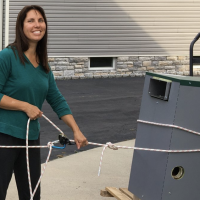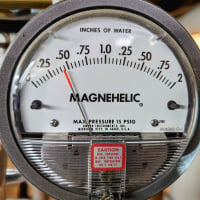Low level Co exposure
Comments
-
with all the rules and regulations and that $hit still goes on!
0 -
I know EXACTLY what you speak of. The general public glaze over & don't wanna hear it when it comes to CO monitoring & the best protection. After my first weekend training with Jim Davis and NCI, over 25 years ago, I was Soooooo Gung-Ho and ready to conquer the CO world that I purchased two cases!!!! Around 50!!! Low level CO monitors and took out a full page ad in my Village Newspaper for about 4 weeks....
I didn't get one phone call and it took my several years!! To recoup my investment. The general public look at you like a snake oil salesman & a shyster....Ignore that.
That being said, use your combustion analyzer on every appliance you work on and keep telling the truth. I know I have saved a few lives from being lost to CO disasters in the making..
I will put you in touch with Jim & NCI
Mad Dog
1 -
-
-
-
Yup...the Stop sign ONLY goes up after Johnny gets run over...after years of complaints. This happened around the block from me RIP little buddy A.B.) .Infuriating! Mad Dog
0 -
-
One problem with low level diffuse risks: there are so many of them that you don't know which to deal with first.
Do you monitor for CO? CO2? VOCs? Radon? Mold spores? Lead dust?
All of these things are real issues. Where do you put your money first?
Thanks for bringing up CO; I actually didn't know that there was endogenous CO, and hadn't figured it in to my monitoring choices.
0 -
I put CO monitoring above those others because the danger is imminent. Mad Dog
0 -
agreed. Definitely remove all interior-vented gas appliances immediately
NJ Steam Homeowner.
Free NJ and remote steam advice: https://heatinghelp.com/find-a-contractor/detail/new-jersey-steam-help/
See my sight glass boiler videos: https://bit.ly/3sZW1el1 -
i believe endogenous CO means that it is produced in your body in tiny amounts as part of normal metabolic reactions.
0 -
It is but that amount is dwarfed by artificial sources of course
NJ Steam Homeowner.
Free NJ and remote steam advice: https://heatinghelp.com/find-a-contractor/detail/new-jersey-steam-help/
See my sight glass boiler videos: https://bit.ly/3sZW1el0 -
well that is the question isn't it, at what concentration does it bind to enough hemoglobin to be significant compared to natural death of red blood cells.
0 -
I poked at this a bit. This is not my field of work, but I've had to read a bunch of technical academic papers and can help pull out some useful info.
Don't confuse 'COHb %' and 'PPM CO'. COHb is Carboxyhemoglobin, where hemoglobin in your blood is bound to carbon monoxide, and thus can't carry oxygen. PPM CO is parts per million carbon monoxide in the air. PPM CO is a measure of how toxic the air is, COHb % is a measure of how the toxin has impacted a person.
This is what looks like a broad survey article that covers known high level risks and potential low level risks:
Table 2.1 is particularly interesting, the first several rows describe harm at levels below the threshold for most alarms:
This table also suggests an answer to the question 'how much exposure is enough to be discernable beyond normal endogenous COHb levels?' Normal COHb levels are <0.5%; exposure to 1 ppm CO leads to a COHb of 0.5%, so I'd say the threshold for discerning changes from external CO exposure is about 1 ppm.
2 -
-
I think they are saying that a typical non-smoker has COHb levels of 0.5-1.5%, and then they calculate the exposure that causes this level as somewhere in the range of 1-8 ppm.
The next lines in the chart say that levels which overlap the typical levels are associated with problems in various studies.
0 -
-
-
-
@Mad Dog_2 By The Police. Excellent song.
Single pipe 392sqft system with an EG-40 rated for 325sqft and it's silent and balanced at all times.
1 -
Every heating season consumers are told to get their heating system checked and serviced. Why?
0 -
How many deaths by "natural causes" are either CO directly or a significant contributing factor? What about chronic low level CO poisoning as a co-morbidity? Who is tracking this? Unless there is an autopsy, it will be missed and depending upon how long the body sits before they get it into the morgue and draw blood, the test results may be skewed. That means they would have to look microscopically for signs of cellular hypoxia, which can be vague and not well translated to exposure levels. Since the half-life is roughly 3 hours, delays in getting blood drawn are a big problem in calculating the acute exposure levels. Then, too, while you can draw venous blood (unlike your typical arterial blood gas analysis or ABG), you still need a blood gas analyzer to test it. You're not going to find that machine at your local Doc in the Box urgent care clinic- you need to go to a tertiary care hospital, especially if you have a level I trauma center with a hyperbaric oxygen (HBO) chamber. You cannot assume. There are more HBO chambers in Columbia, SC than Philadelphia, PA. Go figure. There is not an HBO in-hospital facility in New Castle Co, DE but there is an out patient clinic 30 minutes from the hosptial on the other side of Wilmington. Not a good option when you have an acute CO poisoning to treat, especially after hours. Also, they don't do pts. on ventilators or other specialized equipment. You need to know your local capabilities and resources.
There are no CO badges for employees to wear that track their Time Weighted Averages as well as violations of the Permissible Exposur Levels. How/ where does this reflect in an employee's employment and medical records? What if a guy routinely exceeds the PEL or TWA from small engines but is never acute enough to warranty treatment at a hospital where it might enter into his records. How would, for instance, a cardiologist know this guy has suffered daily violations, which might have bearing on his treatment of that patient? What about someone suffering from cognitive issues? They get packed away on psych drugs stuck in a human warehouse? How about the misdiagnosis of idiopathic 'allergies', ADHD, COPD, CVA, etc.? How many pts. are misdiagnosed and, therefore mistreated annually? While the rumor was that medical malpractice was the 3rd leading cause of death, which seems to be a bit overinflated ACCORDING TO THE MEDICAL COMMUNITY but the 300-400K deaths from malpractice is generally accepted. CO, as a causative agent, is extremely preventable in the home, workplace, travel, and is quite quick, cheap and simple to diagnose and detect. The technology to detect and alert is cheap and readily available. It's the politics killing people as usual.
2 -
We used the MSA Altair - 4 gas monitors at work and our alarms were set to go off at 35ppm on the CO. It was not unusual at all while we were splicing and working with the torches in the vaults or manholes to set off the alarms on a regular basis through out the day. You'd just stop torching for a minute and yell at your helper to hit the button to silence the alarm. When we went into the buildings with the FDNY after they knocked down a fire and we killed the power to investigate a building fire to see if it may have impacted the electric service we would wander around all over the place reading CO but would leave to don our SCBA's if it went up towards 100ppm and set up power ventilation until is was below 35 again and continue venting until 0ppm for 3 consecutive shifts.
1 -
@Bob Harper 's question goes to the point that I don't think we really have useful data on the subject.
We would need a long term longitudinal study (years and lots of people) where we monitor their CO exposures (and probably other exposures, since we are already doing most of the work, eg. radon, NOx, PMxx…) and correlate this with their health. Doing these sort of studies is hard, both technically (actually doing the study) and politically.
Think about the kerfuffle about gas ranges and asthma.
The data presented here is enough that I'm shopping around for CO monitors, but not enough that I'm actually going to change anything in my home unless I detect elevated CO levels.
2 -
or CO vs NOx or possibly both since NOx will reduce lung function and CO will reduce capacity to absorb oxygen in to the blood.
0
Categories
- All Categories
- 87.3K THE MAIN WALL
- 3.2K A-C, Heat Pumps & Refrigeration
- 61 Biomass
- 429 Carbon Monoxide Awareness
- 120 Chimneys & Flues
- 2.1K Domestic Hot Water
- 5.8K Gas Heating
- 114 Geothermal
- 166 Indoor-Air Quality
- 3.7K Oil Heating
- 77 Pipe Deterioration
- 1K Plumbing
- 6.5K Radiant Heating
- 395 Solar
- 15.7K Strictly Steam
- 3.4K Thermostats and Controls
- 56 Water Quality
- 51 Industry Classes
- 50 Job Opportunities
- 18 Recall Announcements










